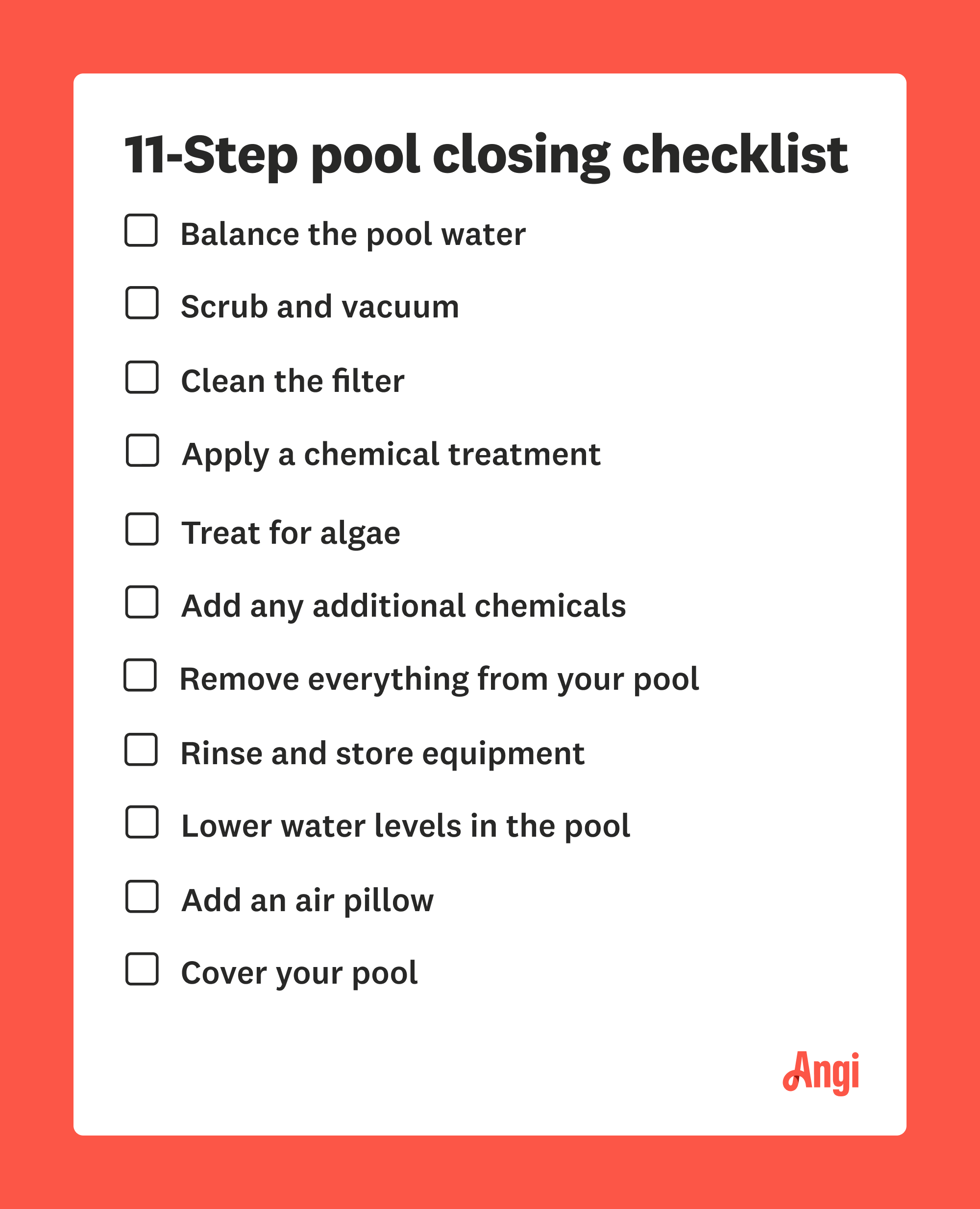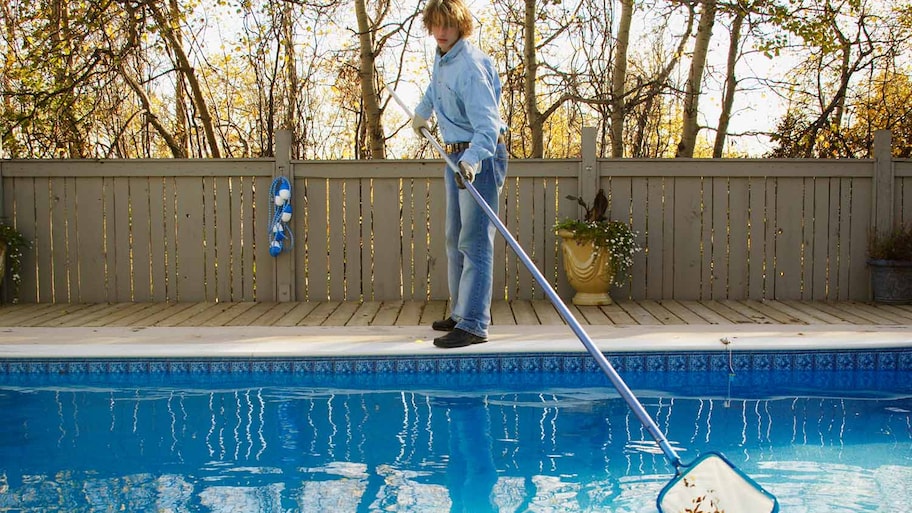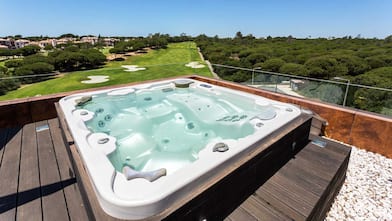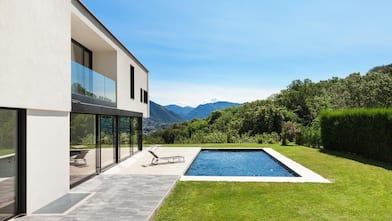Set your pool up for summer success
You splashed your way through summer, but now it’s time to prep your pool for frigid temperatures. Learn how to close a pool for winter, whether you have an above- or below-ground pool, to keep it clean and damage-free.
When the heat returns, your pool will be ready and waiting for pool parties and non-stop fun all summer long.
Why Do You Need to Close Your Pool for Winter?
You’ve put away the pool rafts and picked up all the beach towels—isn’t that enough? Actually, a common pool care mistake is not properly closing your pool for winter.
In fact, there are lots of benefits of winterizing your pool, including the following:
Prevents cracking or other freeze-related pool repair costs
Can extend the pool’s lifespan
Pool filter won’t have to work as hard to remove downtime debris
Keeps the pool clean and algae-free come summer
Reduces maintenance and repair costs down the line
How to Prep for Closing Your Pool for Winter
If you haven’t yet, purge your pool of all paraphernalia before beginning the winterization process. Deflate the floats and lift out ladders and noodles. Clean and fully dry off all accessories before storing them in a cool, dry, and dark spot.
How to Close a Pool for Winter

It’s time to take the plunge to get your pool in order for wintertime. Follow the steps below to learn how to close a pool for winter.
1. Check the Water Chemistry
Buy a pool testing kit to confirm the pH and calcium levels of your pool and adjust accordingly. If your levels are too low, it can lead to liner damage. You’ll need to raise pool pH levels before closing it for winter if this is the case.
Aim for the higher ends of the ranges so the winterizing pool chemicals last longer through the covered months:
Alkalinity: 80–120 parts per million (ppm)
pH: 7.3–7.6
Calcium hardness: 175–225 ppm
2. Shock the Pool Water
Shocking your pool helps to kill off any bacteria and algae before closing it. Chlorine and non-chlorine shock solutions are available. While chlorine-based products are more effective at removing algae, don’t use them in above-ground pools. The harsh chemicals can corrode vinyl or plastic pool walls.
To shock the water, follow these steps:
Wear protective eyewear and chemical-resistant gloves.
Carefully read the manufacturers’ instructions, as the process can vary depending on the type of chemical.
Slowly add the shock to a 3/4-filled bucket of warm water. Stir carefully until it is completely dissolved.
If you don’t need to add the shock to the water, add it directly to the pool.
Walk around the pool while pouring the shock for more even distribution.
Ensure the pump and filter continue to run for around 12 hours after adding the shock to help circulate it around the pool.
If your pool is particularly grubby, you might have to repeat this process several times.
Aim for safe chlorine levels between 1–3 ppm.
3. Add Algaecide (Optional)
Scrubbing and shocking should help inhibit algal growth, but if you’re concerned, you can add an algaecide too.
Apply at least 24 hours after shocking (mixing chlorine and algaecide together at the same time renders both of them useless), and select a product that’s safe to use alongside your shock chemicals. Properly circulate the algal treatment by running the pump for another 24 hours.
Alternatively, lift the cover of your pool every few weeks during winter and if you see any signs of algae growth, add the algaecide then.
4. Do a Deep Clean
Leaving algae, leaves, and other debris floating through the winter isn’t a good look when you open your pool come summer. And worse, not keeping up with pool cleaning can lead to staining and damaging algae buildup.
Include the following tasks in your winter pool cleaning checklist:
Pour in a scale and stain remover a night or two before you plan to cover your pool.
Use a skimmer net to scoop out all the leaves and other dirty debris.
Gently scrub the base and sides of the pool with a pool brush.
Use a pool vacuum to pick up the hard-to-reach fragments on the pool floor.
5. Lower Water Levels
Don't empty your pool of water in the winter, as this can dry out and damage the liner. However, you usually have to drain it slightly using a pump or hand siphon (unless you live somewhere it doesn't freeze). This part of the process varies depending on whether you have an above- or in-ground pool.
Above-Ground Pool
If you use a plate to cover the skimmer, you won’t need to drain any water.
If you don’t use a skimmer plate, drain the water to just below the skimmer line.
Don’t drain the water too much, as it can’t support the cover when it collects snow.
In-Ground Pool
If you live where the water freezes, drain the water to just below the skimmer or tile line.
The final level depends on your pool cover—check the manufacturer's instructions. Typically, you can lower the water around 12–18 inches below the skimmer with a mesh cover and 3–6 inches below with a solid cover.
6. Drain Pump and Other Equipment
Don’t leave any water in the pumps, heaters, or filters. Continual freezing and thawing can damage the equipment and promote mold growth. Drain water, dry, and then store the fittings in a safe spot.
7. Blow Out Pool Lines
Clearing the lines in an above-ground pool is relatively straightforward, as they’re easy to access. Call in the pros if you’re unsure about following the instructions for draining the lines in your in-ground pool.
Remove skimmer baskets.
Remove screw-like return fittings that are found around the pipes.
Make sure the water you are blowing out goes in the right direction by turning the valve to the filter or recirculating position.
Attach the air compressor (and adapter if you need it) to the pump’s drain plug and turn it on.
When you see water leaving the pool skimmer and jets, turn the compressor off.
Clean water out of the skimmer.
Once the skimmer is dry, block off the hole in it with a rubber skimmer plug.
Turn on the compressor again and watch for air bubbles coming out of the return lines (usually after a couple of minutes) and then plug them off too.
To move air toward and out of the main drain, set the valve in front of your pump to the main drain setting. After around a minute of running the air compressor, you should see bubbles at the deep end of the pool. Switch off the compressor at this point.
Turn your pump valve back to the skimmer line setting so it’s ready for next season.
8. Pop in a Winterizing Pill
Want to go a step further with winter protection? You can add a winterizing pill. They’re not essential but are wallet-friendly and easy to apply.
This pool maintenance product is actually a floating pill that slowly releases enzymes to help prevent scale, stain, and bacteria buildup. The pill comes in varying sizes, depending on how much water your pool holds.
Always check individual manufacturer instructions, but the simple process for adding a winterizing pill is usually as follows:
Shake the pill in its packet before opening.
Locate and remove the piercing tool.
Use the tool to pierce the recessed section of the pill.
Pop the pill into your pool and leave it to do its work over the winter.
9. Add an Air Pillow for an Above-Ground Pool
Use this for above-ground pools that don’t have the insulating wall protection that in-ground pools do. An air pillow sits between the water and the cover, helping absorb the freezing and thawing pressure.
Always check individual manufacturer instructions, but the steps for installing an air pillow are as follows:
Allow for compression of the air pillow and only inflate it to between 60%–80%.
Attach a strong string to the grommets on the pillow ends.
Pop the pillow into the center of your pool.
Tie the string taut to the pool edge to prevent the pillow from moving around.
10. Cover Your Pool
Keep your pool free from leaf litter and other debris by securing a weather-resistant and well-fitting pool cover rather than a flapping makeshift tarp.
Mesh and solid vinyl are the two main types of pool covers available. Mesh covers are economical and low-maintenance, but small pieces of debris can sometimes sneak through the cover and into the water.
Solid covers are pricier and a pump is often needed to keep rainwater and snowmelt off the top, but they are better at keeping the pool debris-free.
Even with a cover, keep kids and dogs away from the pool area. Water that pools on the cover surface presents a drowning risk.
11. Monitor on a Monthly Basis
If you want to ensure your pool remains bacteria, stain, and scale-free through the winter, buy some extra kits to do monthly checks on your pool’s chemical levels. As a reminder, you’re looking for alkalinity levels of 80–120 parts-per-million (ppm), pH levels of 7.3–7.6, and calcium hardness of 175–225 ppm.
Tips for Safely Dealing With Winterizing Pool Chemicals
Handle pool closing chemicals with care. Follow these tips to help keep you safe.
Use goggles, rubber gloves, and a dust mask to prevent irritation and inhalation of strong fumes.
Add chemicals directly to the pool water or into a bucket of water. Adding water to the chemicals increases the chance of inhaling fumes and dust.
Always read the manufacturer's instructions.
DIY vs. Hire a Pro
It just takes a bit of elbow grease to skim debris and scrub pool walls, but getting it wrong with chemical levels can lead to safety issues and damage.
If you only want to associate your pool with relaxation or you’re nervous about adding the right amount of chemicals, call in a local pool maintenance professional. They’ll also run a trained eye over the walls, filters, and other equipment. The longer you leave a leaky pipe or faulty filter, the higher the cost of the pool repairs.
Pros typically charge $50 to $100 per hour to help winterize your pool. So expect to pay $150 to $300 for this pool maintenance cost. Doing it yourself may cost $50 to $150, depending on whether you bulk buy the chemical products.
Frequently Asked Questions
The key chemicals you need to winterize your pool include chlorine, pool shock, winter algaecide, scale, and stain remover. These all help to keep algae, stains, and bacteria at bay. Depending on the pH levels and calcium hardness in your pool, you might also need acidic or alkaline substances and calcium chloride.
Covering your pool too early increases the chance of a buildup of bothersome algae that flourishes in warm water. This buildup will mean more work for you come springtime. Aim to have everything done before temperatures consistently drop below 65 degrees Fahrenheit. This is usually around September or October, depending on where you live.
A hard freeze can damage walls, pipes, filters, and other gear, and debris buildup can lead to harmful algal formation. When you open your pool up again at the end of spring, without having gone through the winterization process, you might be faced with leaky pipes, wall corrosion, and cloudy bacteria-filled pool water.
Take the time to lift out all the fallen leaves. Doing this means your pool is less likely to suffer from staining and algal buildup over the winter. Algal growth is difficult to clean away, can degrade pool surfaces, lead to costly repairs, and encourages the formation of bacteria.





